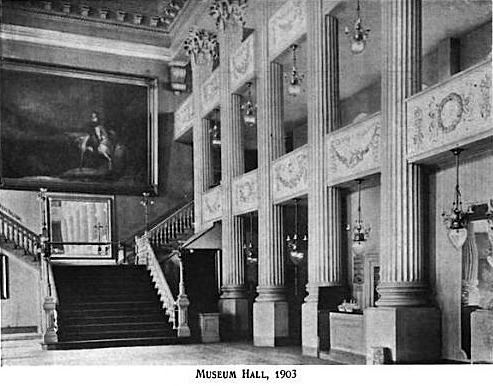 | ||
The Boston Museum (1841–1903), also called the Boston Museum and Gallery of Fine Arts, was a theatre, wax museum, natural history museum, zoo, and art museum in 19th-century Boston, Massachusetts. Moses Kimball established the enterprise in 1841.
Contents
History
The Boston Museum exhibited items acquired from Ethan Allen Greenwood's former New England Museum; tableaux of wax figures; live animals; and artworks by John Singleton Copley, Gilbert Stuart, Benjamin West, Thomas Badger and others. Early live shows presented, for instance, "the musical olio, consisting of solos on glass bells, and birch-bark whistling." Theatrical performances began in 1843. Through the years, notable performers included: Lawrence Barrett, Edwin Booth, John Wilkes Booth, Annie Clark, Richard Mansfield, E.H. Sothern, Mary Ann Vincent, and William Warren.
An advertisement of 1850 described the museum's key attractions:
"The museum is the largest, most valuable, and best arranged in the United States. It comprises no less than seven different museums, to which has been added the present year, besides the constant daily accumulation of articles, one half of the celebrated Peale's Philadelphia Museum, swelling the already immense collection to upwards of half a million articles, the greatest amount of objects of interest to be found together at any one place in America; and an entirely new hall of wax statuary.... and the immense collection of birds, beasts, fish, insects and reptiles;... paintings, engravings and statuary; ... Egyptian mummies, ... family of Peruvian mummies; the duck-billed platypus;... the curious half-fish, half-human Fejee Mermaid;... elephants and ourang-outangs..."
The Museum held a recruiting office for Company D. of the 22nd Massachusetts Volunteer Infantry in 1861 at the start of the Civil War.
Architecture
Hammatt Billings designed the original museum building, located at 18 Tremont Street; In 1846 Hammatt and J.E. Billings also designed the museum's next building, at 28 Tremont Street, located next door to the Massachusetts Historical Society, and close to the King's Chapel Burying Ground. The interior of the museum's 1846 building featured decoration by Ignaz Gaugengigl.
[The building] is arranged in two main portions with an area between for light and air, one communicating with the other at either end by a wide passage. The building upon Tremont Street, the front of which is of Granite in a chaste and beautiful style of Venetian Architecture, with three spacious balconies running the entire length of the building, contains on the first story, five commodious stores, and the entrance to the Museum. Above this story, the whole front building to the eaves, three stories, is occupied as a grand Corinthian Hall... containing the collection. The galleries... are supported by twenty stately columns rising from the floor.... A spacious staircase and passage-way leads to the Exhibition Hall in the rear building... capable of accommodating nearly two thousand persons."
